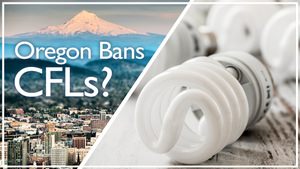Are traditional light bulbs illegal to use? The new light bulb ban affects everyone in the US - but don't worry, we've got the scoop.

Here's the Scoop:
In April of 2022, The Biden Administration in conjunction with the Department of Energy implemented new standards that ban the manufacturing of most traditional incandescent light bulbs past July of 2022 -- and prohibits anyone from selling them past February of 2023. Restrictive yet well-intentioned, these new standards are going to assist many Americans by reducing their energy consumption and saving them on their electric bills.
Yet, we still want answers - why is this happening? We've used light bulbs for over a hundred years and they've always worked fine! Why go through the trouble of banning the good ol' incandescent light bulb, and what are we supposed to use instead of traditional light bulbs?
Why Ban the Traditional Incandescent Light Bulb?
There are two major aspects to the ban. The first redefines the logistics of a 'general service lamp' for clarity in what is and isn't banned.
The other prohibits the sale of any bulb with less than a 45 LpW (lumens per watt) rating. This includes bulbs like:
The DOE (US Department of Energy) believes this is a necessary move to make with our economy and its future as the primary (and arguably sole) motivation. In the end, this will cut tons of carbon emissions and increase savings on energy bills for the consumer. All together, the American economy is looking at saving upwards of 3 billion dollars per year.
NOTE: While this may change in the future, the current ban really only applies to bulbs that have suitable LED counterparts.
How Will the Light Bulb Ban Affect Businesses?
For restaurants, offices and other commercial/retail establishments, the conversion from incandescent to LED is easy, especially with the help of a business services team. Simply retrofitting/replacing your current incandescent bulbs and fixtures with LED ones leads you to be in compliance with the new regulations.
For lighting businesses, adapting to the new regulations has entailed the retiring of many types of bulbs. Any type of product retirement is difficult for sales and conversions - but success for lighting businesses lies in the transition from incandescent bulbs to LEDs.
How Will the Light Bulb Ban Affect Me?
While this all may seem a little scary, the end result is a positive one. This regulation will save money for each home or business owner that converts to higher-efficiency lighting.
Can I Still Use Incandescent Light Bulbs?
Don't worry, you can still use incandescent light bulbs - the ban solely applies to the manufacturing and selling of them. So, if you’re not ready to make the switch to LED, you can – for a limited time – still buy incandescent bulbs here! And who knows, maybe they'll last you awhile!

LEDs as an Alternative
LEDs (Light Emitting Diodes) have been compounding in popularity over the course of the 21st century. A cheap, efficient alternative to incandescent bulbs, LEDs are by far the perfect replacement for your incandescent bulbs - heck, it's what they were made for in the first place!
What's the Difference Between Incandescent and LED Bulbs?
The major difference between the functionality of Incandescent and LED Bulbs is the energy usage. Incandescent bulbs burn hot, requiring a lot of energy. LEDs are composed of computer chips and an electronic makeup, making them fundamentally more efficient.
Not only are LEDs generally cheaper than Incandescent bulbs, they also last up to 50 times as long.
What to Keep in Mind When Switching to LED Bulbs
LED Light Bulbs are designed for replacing incandescent bulbs anyway, so they all list a 'replacement wattage'. As long as you match the replacement wattage to the wattage of the incandescent bulb you're trying to replace, the transition will be okay.
That said, keep in mind the color temperature and lumen rating of your current incandescent bulbs - any change here can drastically affect the mood of a room.
Need LEDs? We've got you covered!
We have an expansive catalog of over 150,000 items - many of which are LED Replacement bulbs. We offer many LED A-Shaped bulbs, which serve as great replacements for traditional types. We also offer many LED Flood Replacements, and even LED Filament and Designer bulbs.
- LED A-Shaped Bulbs - Traditional bulbs used around the house, in lamps and fixtures
- LED Flood Lights - Higher-powered traditional lights, generally used to illuminate larger spaces
- LED Globe Lights - Globe shaped bulbs which are usually found in bathrooms and decorative spaces
- LED Antique Filament Bulbs - Designer bulbs often found in lounges, restaurants and hotels
- LED Retrofit Bulbs - Replacement bulbs for higher-intensity lights such as HIDs, CFLs and Halogens
For further assistance, feel free to call our customer service line at 800-948-1063!






